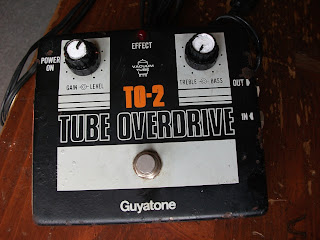This is the ZVEX Super Hard-On, a combination overdrive/distortion pedal from legendary pedal builder Zachary Vex of Minneapolis, Minnesota. I got this pedal in a trade for a Guyatone TO-2, and I'm happy with the deal, especially since this is one of the earlier versions of the pedal hand-built and hand-painted by Zachary himself.
The sound of this pedal is very versatile, ranging from a very slight boost to a raunchy, balls-out distortion that few pedals can achieve on their own.
With the knob turned down (between 0 and 30%), this pedal resembles a clean boost not unlike an MXR Micro-Amp. Like the Micro-Amp, the Super Hard-On retains the shape of your original signal very effectively, pretty much boosting all frequencies evenly. In front of a tube amp, the effect is similar to a Tube Screamer with the "drive" knob turned down and the "level" knob around 5, resulting in a rich, bluesy tone without too much colouring.
As you turn the lone knob on the Super Hard-On up a little (resulting in the signature "crackle" that the pedal itself will tell you is OK) you start to experience the "Super" overdriven sound that makes this pedal extra special. The only thing I can compare the sound to is 3 or 4 tube screamers plugged into each other, with the drive circuits feeding each other to create a layered and convoluted distorted signal that is a little hard to take, but really satisfying if you are looking for a Hendrix-like tone without resorting to a Ringer or Octaver as a companion to your OD/Distortion.
My major complaint about this pedal is also related to its name: the pedal is so-called because it is super hard on your amp, apparently too hard for my vintage Gibson Gibsonette amplifier, which stopped working a few weeks after I started using this pedal. This is because the output voltage of the pedal is extremely high, causing sensitive circuitry to suffer when it is pummeled by the growling signal coming out of the pedal when the knob is turned up. ZVEX recommends avoiding this issue by keeping the knob turned down a little, but where's the fun in that?
The Verdict: This pedal does what it does with style and flair. As far as OD/Distortion pedals go, this one is great at retaining the integrity of your guitar's tone. However, if you have the means and the space on your pedal board, you are probably better off using a clean boost alongside a distortion pedal, as this will give you more control over the individual characteristics of each.
Price Range:
$150-$250 (some pedals are custom painted, and fetch more $, as do some earlier versions)
Highs:
-Looks awesome!
-True Bypass switch
-Solid construction
-Good signal retention
Lows:-Killed my amp :(
-Sideways construction makes an awkward fit on pedal boards
-No external power jack
-Crackle on the knob (it's OK, but not so nice)
Rating: 5.5/10
The sound of this pedal is very versatile, ranging from a very slight boost to a raunchy, balls-out distortion that few pedals can achieve on their own.
With the knob turned down (between 0 and 30%), this pedal resembles a clean boost not unlike an MXR Micro-Amp. Like the Micro-Amp, the Super Hard-On retains the shape of your original signal very effectively, pretty much boosting all frequencies evenly. In front of a tube amp, the effect is similar to a Tube Screamer with the "drive" knob turned down and the "level" knob around 5, resulting in a rich, bluesy tone without too much colouring.
As you turn the lone knob on the Super Hard-On up a little (resulting in the signature "crackle" that the pedal itself will tell you is OK) you start to experience the "Super" overdriven sound that makes this pedal extra special. The only thing I can compare the sound to is 3 or 4 tube screamers plugged into each other, with the drive circuits feeding each other to create a layered and convoluted distorted signal that is a little hard to take, but really satisfying if you are looking for a Hendrix-like tone without resorting to a Ringer or Octaver as a companion to your OD/Distortion.
My major complaint about this pedal is also related to its name: the pedal is so-called because it is super hard on your amp, apparently too hard for my vintage Gibson Gibsonette amplifier, which stopped working a few weeks after I started using this pedal. This is because the output voltage of the pedal is extremely high, causing sensitive circuitry to suffer when it is pummeled by the growling signal coming out of the pedal when the knob is turned up. ZVEX recommends avoiding this issue by keeping the knob turned down a little, but where's the fun in that?
The Verdict: This pedal does what it does with style and flair. As far as OD/Distortion pedals go, this one is great at retaining the integrity of your guitar's tone. However, if you have the means and the space on your pedal board, you are probably better off using a clean boost alongside a distortion pedal, as this will give you more control over the individual characteristics of each.
Price Range:
$150-$250 (some pedals are custom painted, and fetch more $, as do some earlier versions)
Highs:
-Looks awesome!
-True Bypass switch
-Solid construction
-Good signal retention
Lows:-Killed my amp :(
-Sideways construction makes an awkward fit on pedal boards
-No external power jack
-Crackle on the knob (it's OK, but not so nice)
Rating: 5.5/10


















































